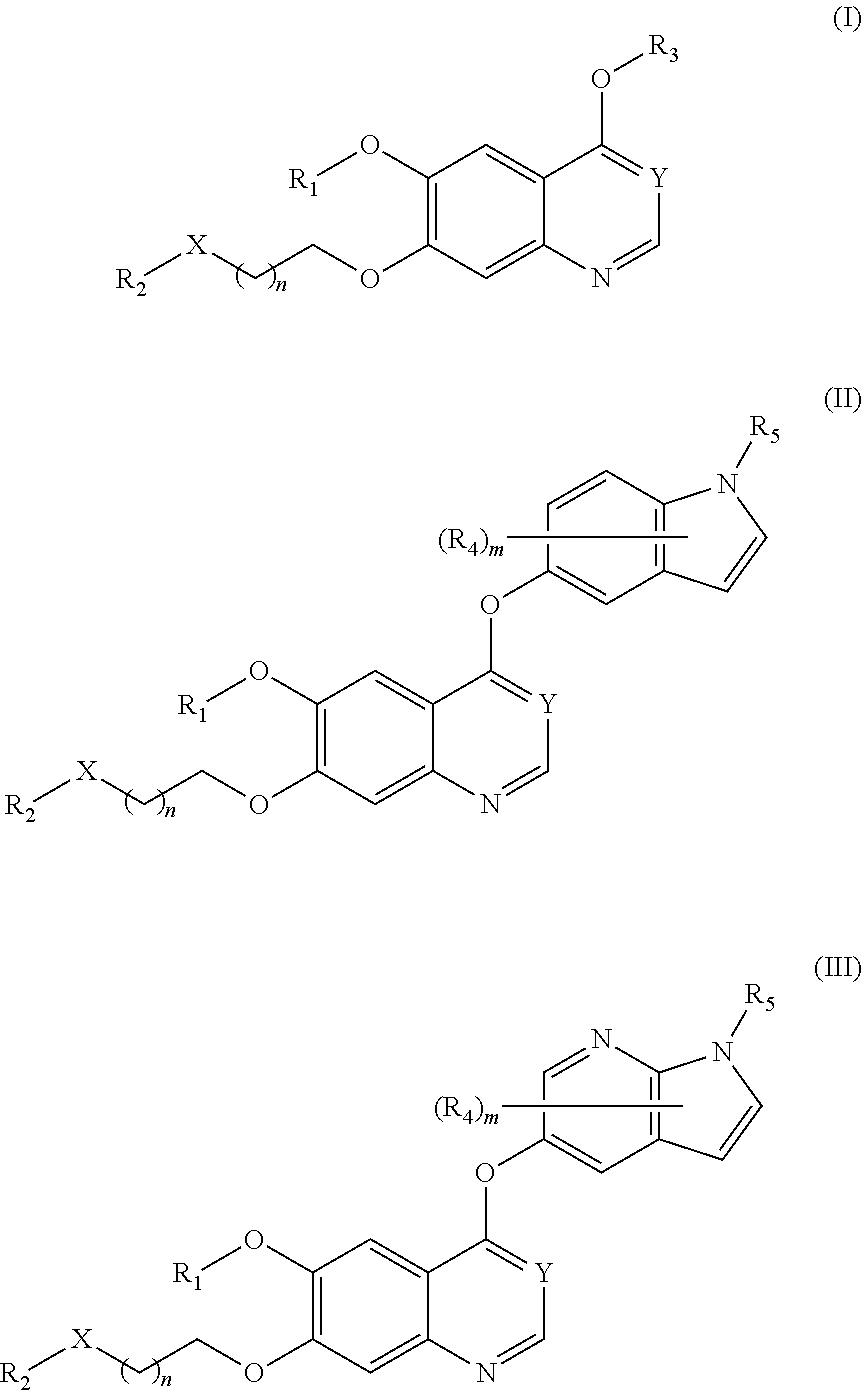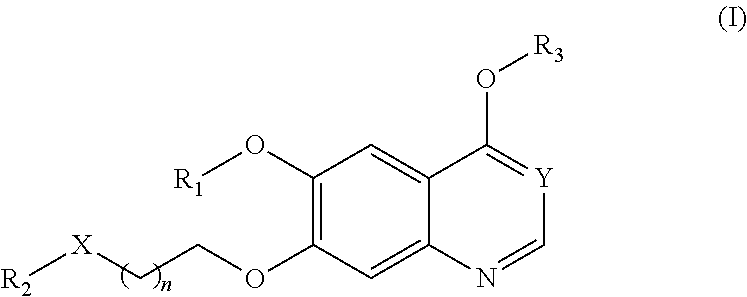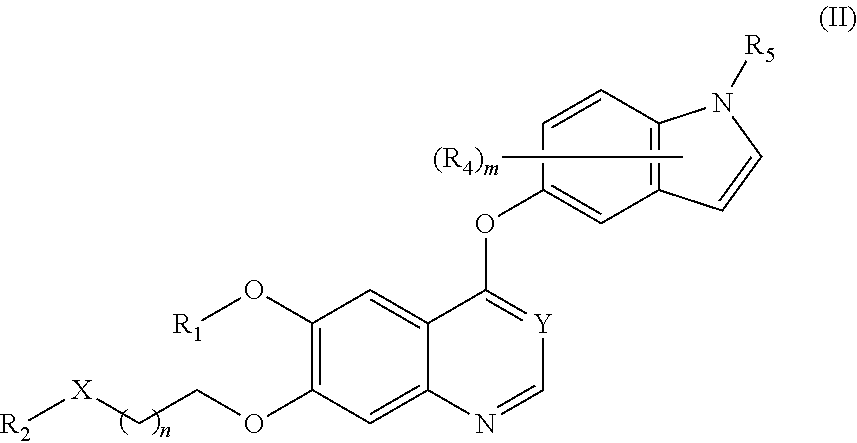Therapeutic compounds and uses thereof
a technology of proliferative diseases and therapeutic compounds, applied in the direction of drug compositions, immunological disorders, metabolism disorders, etc., can solve the problems of irreversible vision loss in developed countries, and achieve the effect of quick elimination, effective delivery of the intended therapeutic effect, and rapid penetration of mucus
- Summary
- Abstract
- Description
- Claims
- Application Information
AI Technical Summary
Benefits of technology
Problems solved by technology
Method used
Image
Examples
example 1
Synthesis of Compound 4 of Scheme 1
Compound 1: 4-(4-fluoro-2-methyl-1H-indol-5-yloxy)-7-(benzyloxy)-6-methoxyquinazoline
[0325]
[0326]4-Fluoro-2-methyl-1H-indol-5-ol (0.53 g, 3.2 mmol) and was dissolved in N,N-dimethylfomamide (25 mL). The suspension was purged with nitrogen and potassium carbonate (0.92 g, 6.7 mmol) was added. 7-(Benzyloxy)-4-chloro-6-methoxyquinazoline (Compound 1, 1.0 g, 3.3 mmol) was added and the suspension was purged with nitrogen again. The suspension was heated overnight at 85° C. in an oil bath. The solvent was evaporated. The residue was treated with water (100 mL) and sonicated. The solid was filtered off, washed with water and hexanes, and dried in high vacuum overnight leaving Compound 2 as a gray solid (1.4 g, 100%). m / z: 430 (M+H, 100%) (positive ionization mode).
Compound 3: 4-(4-fluoro-2-methyl-1H-indol-5-yloxy)-6-methoxyquinazolin-7-ol
[0327]
[0328]4-(4-fluoro-2-methyl-1H-indol-5-yloxy)-7-(benzyloxy)-6-methoxyquinazoline (Compound 2, 0.46 g, 1.1 mmol) w...
example 2
Synthesis of Compound 9
Compound 6: Ethyl 4-(4-chloro-6-methoxyquinazolin-7-yloxy)butanoate
[0331]
[0332]To a solution of 4-chloro-6-methoxyquinazolin-7-ol (compound 5, 3.0 g, 14.25 mmol) and ethyl 4-bromobutanoate (4.53 g, 28.49 mmol) in tetrahydrofuran (30 mL) was added potassium carbonate (5.90 g, 42.74 mmol) and the mixture was stirred overnight at room temperature. The reaction mixture was diluted with water (60 mL) and extracted with ethyl acetate (100 mL×2). The combined organic phases were concentrated to give the crude product as a yellow solid. The crude product was purified by silica gel column (gradient of hexane:ethyl acetate 10:1 to 2:1) to give Compound 6 (3.7 g) as a yellow solid.
Compound 7: Ethyl 4-(4-(4-fluoro-2-methyl-1H-indol-5-yloxy)-6-methoxyquinazolin-7-yloxy)butanoate
[0333]
[0334]To a solution of Compound 6 (5.0 g, 15.39 mmol) and 4-fluoro-2-methyl-1H-indol-5-ol (3.56 g, 21.55 mmol) in acetonitrile (50 mL) was added cesium carbonate (15.05 g, 46.18 mmol). The rea...
example 3
Synthesis of Compound 13
[0339]
Compound 11: 4-(4-Fluoro-2-methyl-1H-indol-5-yloxy)-6,7-dimethoxyquinazoline
[0340]A solution of Compound 10 (739 mg, 3.3 mmol), 4-Fluoro-2-methyl-1H-indol-5-ol (530 mg, 3.3 mmol), and potassium carbonate (920 mg, 6.7 mmol) in dry dimethyl formamide (10 mL) was heated to 100° C. and stirred for 24 hours. The solution was cooled to room temperature and the solvent evaporated by rotary evaporator. Remaining residue was co-evaporated with methanol (20 mL) and dichloromethane / methanol (50 mL). The product residue was precipitated from water (20 mL) and filtered. Solids were washed with water (20 mL), hexanes (20 mL), and diethyl ether (20 mL). Product was dried under high vacuum to give 910 mg of Compound 11 (yield=78%) as a brown powder.
Compound 12: 4-Nitrophenyl 5-(6,7-dimethoxyquinazolin-4-yloxy)-4-fluoro-2-methyl-1H-indole-1-carboxylate
[0341]A solution of Compound 11 (300 mg, 0.85 mmol) in dry THF was sparged with N2, then NaH (68 mg of 60% dispersion, 1...
PUM
| Property | Measurement | Unit |
|---|---|---|
| Composition | aaaaa | aaaaa |
| Structure | aaaaa | aaaaa |
| Pharmaceutically acceptable | aaaaa | aaaaa |
Abstract
Description
Claims
Application Information
 Login to View More
Login to View More - R&D
- Intellectual Property
- Life Sciences
- Materials
- Tech Scout
- Unparalleled Data Quality
- Higher Quality Content
- 60% Fewer Hallucinations
Browse by: Latest US Patents, China's latest patents, Technical Efficacy Thesaurus, Application Domain, Technology Topic, Popular Technical Reports.
© 2025 PatSnap. All rights reserved.Legal|Privacy policy|Modern Slavery Act Transparency Statement|Sitemap|About US| Contact US: help@patsnap.com



